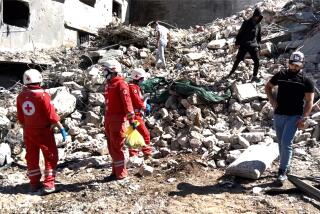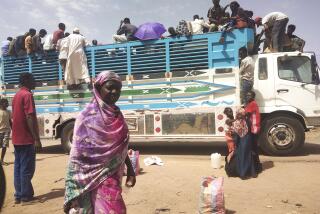In South Sudan, tribal violence adds to fledgling nation’s woes
Reporting from Juba, South Sudan — The two wards are at opposite ends of the hospital. One ward is silent but for a baby boy, gurgling on a bed in a corridor. A toddler wanders around with a machete scar on his head. The boys’ parents are dead.
In the other ward lies one of the men who attacked them. When Gai Nashir was a baby, his father was also killed, by members of the boys’ tribe. Quick to anger, he grew up with an enemy.
“This war began before I was even born,” says Nashir, who was wounded in December when he and other members of his Nuer tribe shot and hacked to death hundreds of men, women and children of the Murle tribe in the darkest episode in the short, troubled history of the world’s newest country, South Sudan.
The ongoing tribal violence, which saw more than 200 people killed last week in the latest outbreak, poses a serious threat to a fragile state still recovering from a long war for independence from the Sudanese government. With memories of the bloodshed in Sudan’s Darfur region fresh, the displacement of 125,000 by the fighting in Jonglei state also raises the risk of yet another humanitarian disaster in a region ill-equipped to handle one.
The tribal tension is just one of the cascading problems that confront South Sudan, including a near-total lack of infrastructure and a war on its disputed border with Sudan that has caused 80,000 people to flee into South Sudan. There is mounting tension with Sudan over oil, most of which went to South Sudan with its independence; talks on the issue reportedly degenerated into a shouting match recently.
The December attacks exposed the government’s failure to protect its citizens, and to offer services and jobs in a destitute region. Bitter young men whose tribes measure their wealth in cows are left reliant on cattle rustling and killing for their livelihood and marriage prospects.
“They’re going to have to face up to national reconciliation,” says a Western observer in Juba, the capital of South Sudan. “The issues for the Nuer and the Murle are basically the same. They feel completely abandoned by the government.
“They were saying: ‘You have to come and help us. We need security, we need a buffer zone [between the tribal areas].’ … The government’s done nothing.”
Bad blood between the Nuer and Murle tribes goes back generations, but a new wave of tribal killings exploded in Jonglei about a month after South Sudan’s rapturous independence celebrations in July.
More than 1,000 have been killed since, according to the United Nations, although there is no definitive casualty figure in the vast, isolated region nearly the size of Iowa, with few roads or facilities such as schools and clinics.
The tribal violence has also seen the reemergence of an 8,000-strong Nuer militia called the White Army.
This week, South Sudan’s government launched a new effort to disarm the White Army and Murle militias, by force if necessary, deploying 12,000 soldiers to carry out the campaign. A statement released by the White Army this month warned of a coup if the government tried to challenge it, vowing that any soldier who “will come to fight us will not go back alive.”
Repeated peace efforts and disarmament of both sides in recent years have failed. Terrified of hated neighbors, with no government protection, people rearm themselves in a country awash withweapons.
The Murle minority of about 148,000 is often casually derided by other South Sudanese as “the problem” because of the tribe’s history of trying to boost its numbers by abducting children of rival tribes.
But U.S. anthropologist Jon Arensen, who spent eight years living with the Murle in the 1970s and 1980s, says its members are often demonized in South Sudan.
“The Murle tribe is being portrayed as the aggressor,” he wrote recently. “The Nuer tribe is being portrayed as noble warriors simply reacting to the attacks of the evil Murle people. Nothing is farther from the truth. Almost all the publicity being generated — both local and abroad — takes the position of the Nuer fighters.”
The two sides fight differently: Murle men move like guerrillas in small bands, attacking, stealing cattle, abducting children and retreating. The Nuer move in huge, heavily armed columns of many thousands, pouring into enemy villages with devastating power.
Nuer militants presaged the December attacks on Pibor and surrounding villages with a statement announcing plans for genocide: “We have decided to invade Murleland and wipe out the entire Murle tribe on the face of the Earth.”
Nashir, 35, married with five children, recounts the attacks on the Murle with grim pride. It was revenge, he says, for an earlier Murle attack on the Nuer town of Pieri. Six hundred were killed in that August attack, and up to 200 abducted, according to the U.N.
“When we saw that, the Nuer asked themselves, ‘Why is this happening?’ Then the Nuer organized themselves to go and attack. All the people from the area joined the fight,” he says.
The August attack by the Murle followed similar attacks in 2010 and 2009, with each side blaming the other, each planning revenge.
As Nashir speaks, another young Nuer limps by on crutches, an ugly bullet wound in his foot.
At the opposite end of the hospital, the ward is crowded with victims. Nyarath Kolitok, who was shot in the arm and lost her 25-year-old daughter in one of the December attacks, takes the orphaned boys whom staff members have named Peter and Paul under her care, feeding them and chattering to them. She hopes someone in Jonglei will claim them as family.
Nearby, a woman shakes her head feverishly, whimpering, eyes shut. Her toddler wanders nearby, squalling.
A boy, about 6, lies motionless as his mother, Agot Korok, spoon-feeds him. When the attack happened, her husband grabbed the boy, Anyibee, and ran.
“They came early in the morning in a big column. They started to shoot people. They shot and killed my husband and they took my daughter.”
The bullet that killed her husband shattered her son’s leg.
Tirito Kudumoch, 25, a Murle shot in the chest during the December attack, says his people couldn’t defend themselves against the huge Nuer column.
“They had big guns like RPGs and AK-47s. In our culture, when you’re attacked, you have a right to fight to protect your things from being taken. But we were disarmed … and we were sitting without guns.
“The government promised they would protect us and protect our property.”
Both sides have long memories, know each other’s weak points and attack at moments of vulnerability, burning down clinics, leaving no one to treat the wounded.
When Nashir was a baby, his father was shot by Murle invaders, and, with no hospitals, died a week later. He grew up with his mother’s story of the killing and of the desperate attempts to save his father with traditional medicine.
As a boy, he was haunted by the idea of an enemy forever on his horizon. As soon as he was old enough, in his teens, he got a gun and joined the fight.
“I was never happy. I was angry,” he says. “My mother used to tell me I should always step forward to defend my brother and sisters. Now, I and my friends take guns, and we get our revenge.”
More to Read
Sign up for Essential California
The most important California stories and recommendations in your inbox every morning.
You may occasionally receive promotional content from the Los Angeles Times.










